Stocks & Equities
OTTAWA (Reuters) – Canada gained a higher-than-expected 30,300 net jobs in February while the unemployment rate rose to 5.6%, official data showed on Friday, but analysts said the data was unlikely to trigger a rethink at the Bank of Canada as it tries to shield the economy from the effects of a coronavirus outbreak.
Analysts in a Reuters poll had forecast a gain of 10,000 jobs in February and an unemployment rate of 5.6%. Wages for permanent employees – a metric watched closely by the Bank of Canada – rose by…Click for full article.
TORONTO – North American stock markets were on edge again Thursday, plunging amid new concerns about the spreading of novel coronavirus and uncertainty over the upcoming U.S. presidential election.
“There’s clearly still a lot of uneasiness happening in the broader marketplace,” said Mike Archibald, vice-president and portfolio manager with AGF Investments Inc.
California declared a state of emergency after a COVID-19 related death and the number of infections doubled overnight in New York. And then Sen. Elizabeth Warren dropped out of the race to become Democratic presidential nominee in an expected boost to rival Sen. Bernie Sanders.
The U.S. 10-year treasury yield dropped to a new low under the one per cent psychological level for investors.
“Until we can get back above one sustainably I think you’re going to see a lot of…click for full article.
It may be the ultimate silver lining story in a week that has seen record stock market declines. The race to develop a vaccine for C0V-ID19, otherwise known as the new coronavirus, has seen a number of bio-tech firms’ share price hit the roof.
IBio (NYSE:IBIO) announced last week that it would be working on a vaccine in it’s Texas lab in conjunction with Beijing-based CC Pharming. The lab started in 2010 and was partially funded by the US Defense Department. It’s leaders were involved in developing a vaccine for MERS. The stock has soared from $0.31 to $2.49. It has traded an astonishing 400,000,000+ shares in just the last 2 days – it was trading less than 3 million shares a day for most of January.

Oral vaccine specialist Vaxart (NASDAQ:VXRT) in San Francisco has seen it’s share price double, as has nanoparticle vaccine developer Novavax (NASDAQ:NVAX) in Maryland.
Closer to home Victoria BC based ImmunoPrecise Antibodies (TSX-V:IPA) announced last week that it had launched a coronavirus vaccine and therapeutic anti-body program in both it’s Canadian and European laboratories. The stock has seen a 20% increase so far, and as a smaller entity, may be flying under the radar screen of US and international investors.

Air Canada stock is a Canadian success story. The airline almost went bankrupt and traded below $1 per share about 11 years ago.
However, it has miraculously turned around and generated tremendous value for its shareholders. Even if you had bought the stock at $8 per share when it showed signs of turning around, you’d still be sitting on a five-bagger!
In the last 12 months alone, the value stock appreciated 35%, handily beating the TSX index….CLICK for complete article
In the first section of this article, we highlighted three key components/charts illustrating why the “rally to the peak” is very likely a result of a continued Capital Shift away from risk and into the US stock market as an attempt to avoid foreign market growth concerns. This method of pouring capital into the US stock market is a process that is driving incredible asset rallies in the US technology sector. Already the US technology sector (FANG and our Custom Technology Index charts) are up almost 15% in 2020. How long will it last and when will it end?
Recently, China has revised the Coronavirus data with a sharp increase in infection cases – now over 40,000. We believe the true number of infections in China are currently well above 250,000 from video content and other data we’ve researched. We believe economic data originating from China for January and February 2020 will show a dramatic 60% to 80%+ decrease in activity for many of the major cities. Satellite technology suggests manufacturing and consumer activity in most major Chinese cities is only a fraction of what would be considered normal – 10% to 20% or normal levels…CLICK for complete article













